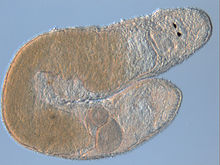Macrostomida
| Macrostomida | |
|---|---|

| |
| An adult Dolichomacrostomum uniporum, a member of the Dolichomacrostomidae | |
| Scientific classification | |
| Domain: | Eukaryota |
| Kingdom: | Animalia |
| Phylum: | Platyhelminthes |
| Subclass: | Macrostomorpha |
| Order: | Macrostomida |
The Macrostomida[1] are a taxon of small basal free-living flatworms (Turbellaria, Platyhelminthes), which inhabit freshwater, brackish, and marine environments. The taxon name was coined by Josef Meixner (1924).[1] There are currently about 260 named species in this taxon.[2]
As is the case for many other taxa, the taxonomic rank of Macrostomida is not very clear.[citation needed]
Description
Macrostomidans are small (~0.5 to 5 mm in length), and generally highly transparent microturbellarians, usually round in cross section, and with only the largest forms being dorsoventrally flattened. They are distinguished from related animals by the possession of a simple pharynx and intestine, and a single pair of lateral nerve cords, and by the absence of a statocyst.[2]
Ecology and distribution
Macrostomidans are members of a large range of aquatic faunas, ranging from the meiobenthos, epibenthos, to plankton. Moreover, they occur in marine, brackish, and freshwater habitats, and many forms are particularly abundant in the intertidal meiobenthos, where they can be exposed to highly variable environmental conditions. There are also many sub-tidal and a few deep-sea forms. They can be found in all major bodies of water worldwide, and in the freshwater of all continents, except Antarctica.
References
- ^ a b Meixner, J. 1924. Über das Ovarium von Microstomum lineare (Müll.) und die Abscheidungsfolge des Schalen- und Dottermaterials bei rhabdocoelen Turbellarien. Zool. Anz. 58:195-213.
- ^ a b Tyler, S., Schilling, S., Hooge, M., and Bush L. F. (comp.) (2006-2009) Turbellarian taxonomic database. Version 1.5 http://turbellaria.umaine.edu/turb2.php?action=1&code=2775
External links
- Turbellarian Taxonomic Database: A listing of the taxonomy of turbellarians (http://turbellaria.umaine.edu)
- Macrostomorpha Taxonomy and Phylogeny EDIT Scratchpad (http://macrostomorpha.info)
